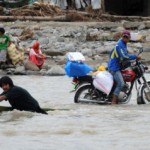 MANILA, Philippines — Fishermen joined Philippine navy sailors, police and firefighters in an ever wider search for bodies from entire villages swept away in one of the country’s worst flash floods. More bodies have washed ashore, pushing the death toll to more than 1,200, an official said Monday.
MANILA, Philippines — Fishermen joined Philippine navy sailors, police and firefighters in an ever wider search for bodies from entire villages swept away in one of the country’s worst flash floods. More bodies have washed ashore, pushing the death toll to more than 1,200, an official said Monday.
While more than 60,000 homeless from hundreds of flood-ravaged villages spent a miserable Christmas in jam-packed schools and gymnasiums, search teams retrieved an additional 150 bodies from the sea as far as 60 miles (100 kilometers) from worst-hit Cagayan de Oro and Iligan cities, said Benito Ramos, head of the Office of Civil Defense.
He said it would take three to six months to restore some normalcy and construct temporary housing to free up schools that are now serving as refugee camps.
The death toll as of Monday stood at 1,236, with about two-thirds of the bodies unidentified. With more bodies found floating farther away, Ramos said authorities sought the help of fishermen to scour the sea.
« We’ve stopped counting the missing. There are no accurate figures, » Ramos said. « Those recovered, we don’t know who they are. We have a system in place so that families can claim them later, based on fingerprints and dental records. »
The United Nations last week launched an urgent appeal for $28 million to help an estimated 600,000 affected people, more than half the population of Cagayan de Oro and Iligan in the southern Mindanao region.
Despite warnings from forecasters, most were asleep Dec. 16 when a tropical storm made a landfall in a region rarely visited by typhoons. It unleashed more than a month’s worth of rainfall in 12 hours, sending walls of water gushing into homes.
Many of the dead were women and children who drowned in their beds. Others scrambled to climb roofs to escape the overflowing rivers and muddy waters that carried dangerous debris and logs from nearby mountains. The logs were still floating off the coast.
President Benigno Aquino III, who banned logging in February following previous flooding deaths that experts say were caused partly by deforestation and soil erosion, has ordered an investigation.
Communist guerrillas in the south canceled Monday’s celebration of their movement’s 43rd founding anniversary and instead promised to donate money to flood victims and punish multinational companies they accuse of environmental destruction.
Rebel spokesman Jorge Madlos told The Associated Press by telephone that they sought funds for victims from huge pineapple and banana plantations and other companies.
« Some were lukewarm to our call, » Madlos said. « That’ll be a factor when we decide which ones to punish first for this destruction. »
Another factor in the staggering death toll was illegal settlements along Cagayan rivers. Thousands of people lived in shanties on the banks and islands directly along the water’s path.
In the evacuation centers, where about a third of the displaced are children, aid workers were providing food, clothes, blankets, bottled water and hygiene kits.
A lack of running water was still a major concern. Many shelters had poor sanitation with open drainage and defecation sites, said Ariel Balofinos, Mindanao manager for Save the Children aid agency.
« Children in particular are susceptible to health threats because immune systems are weak, » he said, adding that many youngsters were also traumatized.
« Many children have witnessed friends and family dying. We’ve come across children who have been orphaned, but the good thing is they have relatives, which is part of the Filipino coping mechanism, » he said.
huffingonnpost



